“I realise now that I wanted to disappear. To get so lost that nobody ever found me. To go so far away that I’d never be able to make my way home again. But I have no idea why.” -Jessica Warman
When you lie down on your back on a clear, dark, moonless night, what is it that you see? If your vision is outstanding and observing conditions are just right, you’re likely to see not only a few planets and thousands of stars, but also star clusters, some faint nebulae, the plane of the Milky Way, and maybe even a distant galaxy or two.
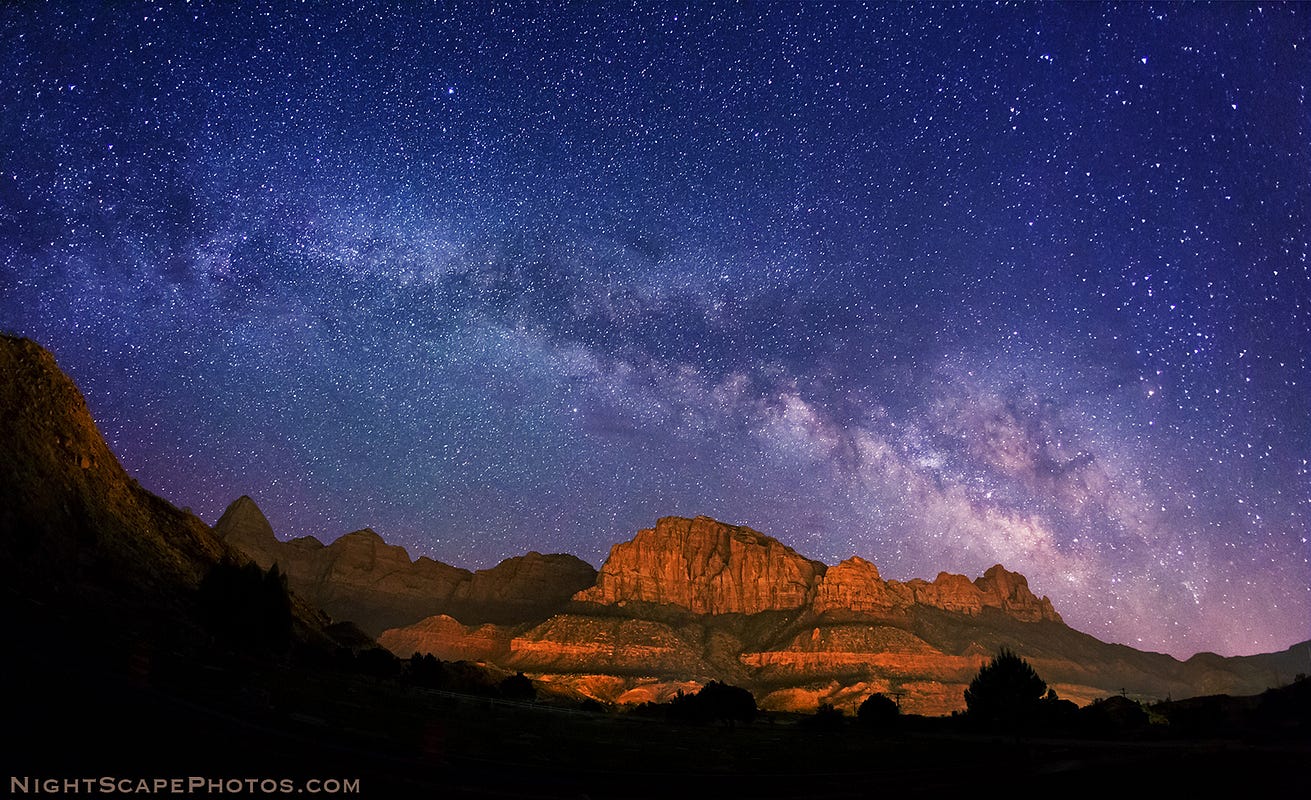
Image credit: © Royce Bair of flickr, viahttps://www.flickr.com/photos/ironrodart/sets/72157627607005290/.
But when you start to look more deeply — beyond what you can see with your naked eye — you start to find that there’s an amazing Universe past our own galaxy, past the stars, clusters and nebulae of the Milky Way out there. What once seemed like faint, fuzzy, inconsequential smudges have since revealed themselves to be distant galaxies, or island Universes not so different than our own, consisting of anywhere from hundreds of millions to many trillions of stars.
And the Universe is full of them, with roughly as many galaxies in the part observable to us as there are stars in the entire galaxy we inhabit.
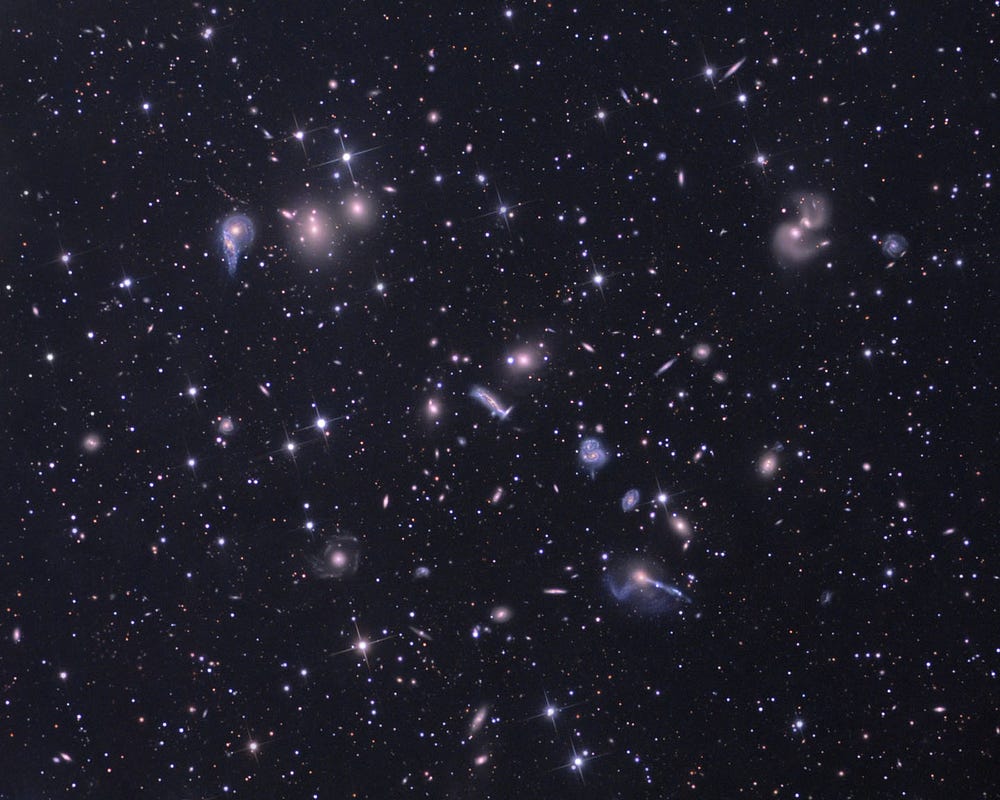
Image credit: Tony Hallas of Astrophoto.com, via http://apod.nasa.gov/apod/ap070719.html.
What’s perhaps surprising about these galaxies is that the farther away we find them, the faster they appear to be moving away from us. This was one of the most puzzling discoveries of the early 20th century, and it was finally put into order by Edwin Hubble (and, independently, Georges Lemaître) who realized that this was a consequence of living in an expanding Universe.
The resultant relation — that the farther away a galaxy is from us, the faster it appears to recede — is known as Hubble’s law. The only exceptions to this rule happen when a galaxy has been subject to an intense,local gravitational interaction, giving it what’s known as a significant peculiar velocity. But on the largest scales, Hubble’s law, or the velocity/redshift relation, shows itself incredibly clearly.
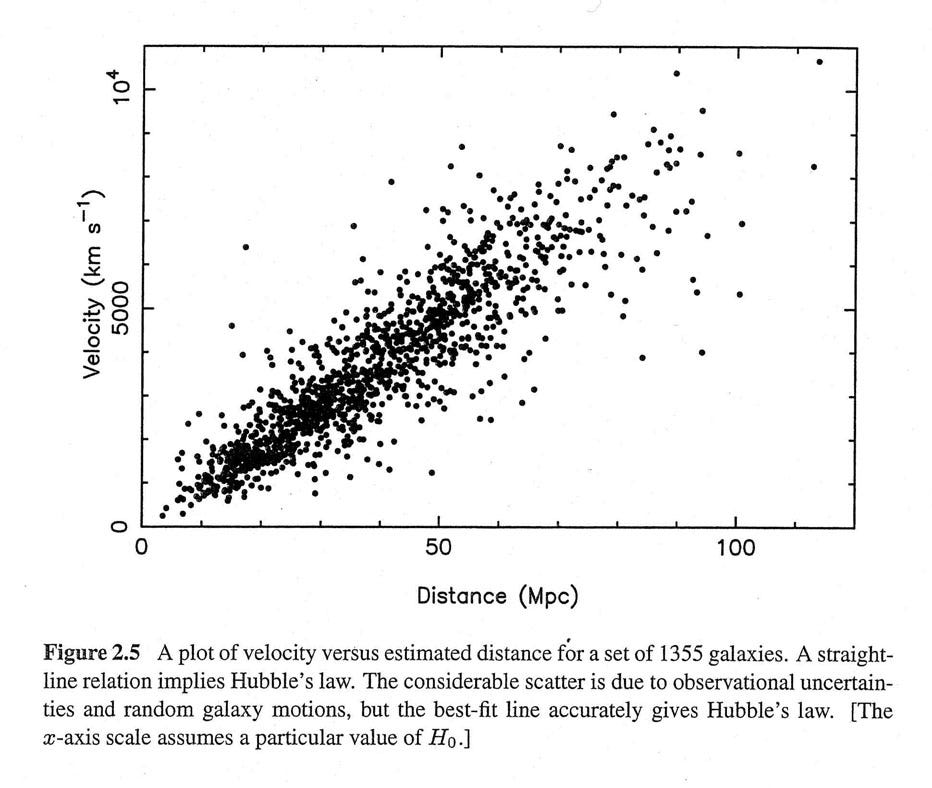
Image credit: Andrew Liddle’s Introduction to Modern Cosmology.
You might instinctively wonder, especially if you know about the framework of the Big Bang, whether this will continue forever or not? Hubble’s famous law was formulated all the way back in 1929, and for the majority of the 20th century, scientists were seeking the answer to that very question.

Image credit: retrieved from John D. Norton at University of Pittsburgh, modified by me.
You see, the Universe originated from a hot, dense, very rapidly expanding state. It was full of matter and radiation, and over time it expanded, cooled, and the expansion rate began to slow. In addition, gravitational imperfections grew into galaxies and clusters of galaxies, or shrank into great cosmic voids.
From a time billions of years ago when the Universe was almost perfectly uniform, with no life, planets, stars or galaxies in it, we now have — on average — hundreds of billions of stars in each of hundreds of billions of galaxies, populating an observable Universe some 92 billion light years across. And it looks something like this.
https://www.youtube.com/watch?v=08LBltePDZw
Sure, the Universe started off expanding very rapidly, but it also started out with a tremendous amount of matter-and-energy in it. Over time, gravitation slowed the expansion rate down. And things are still expanding… for now.
But that’s our past history. What about the future?
You can imagine — as most scientists did for most of the 20th century — three possible scenarios:
-
Gravity wins. If there’s
enough matter-and-energy, then gravitation could eventually overcome the initial expansion. The Universe will reach a maximum size where the expansion rate drops to zero, and then a contraction phase begins. Over enough time, the Universe will return to a hot, dense state, and ends in a fiery fate known as the Big Crunch.
-
Expansion wins. If there
isn’t enough matter-and-energy, then gravitation fails to slow down the initial expansion sufficiently. Distant galaxies will continue to recede away, and even though the expansion rate drops, it will never reach zero and will never reverse itself. Eventually, everything will be so far apart that it will end in a state where all its matter is arbitrarily close to absolute zero: the Big Freeze.
-
The “Goldilocks” case. If the Universe had just
one more proton in it, it would recollapse and end in a Big Crunch. If it had just
one fewer proton, it would expand apart forever. But in a
critical Universe, the expansion rate and gravity sit right on that edge. The expansion rate asymptotes to zero, but freezes at the slowest possible rate without recollapsing.
For a long time, we attempted to measure which of these three options described our Universe. Was it going to recollapse, was it going to “coast” forever, or was it the critical case?
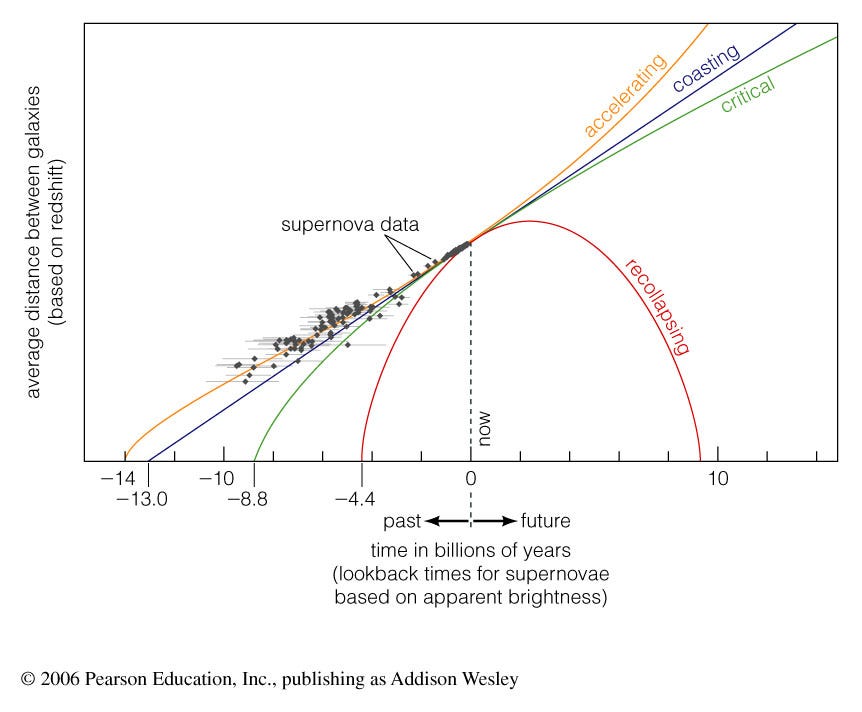
Image credit: Pearson / Addison-Wesley.
Imagine our surprise when the data came in — just in 1998 — indicating that it was none of these options! Instead, the expansion rate isn’t going to keep dropping, but will asymptote to a finite, non-zero value.
This means that each and every galaxy, as it moves farther away from us, will recede faster and fasterover time, appearing to accelerate away!
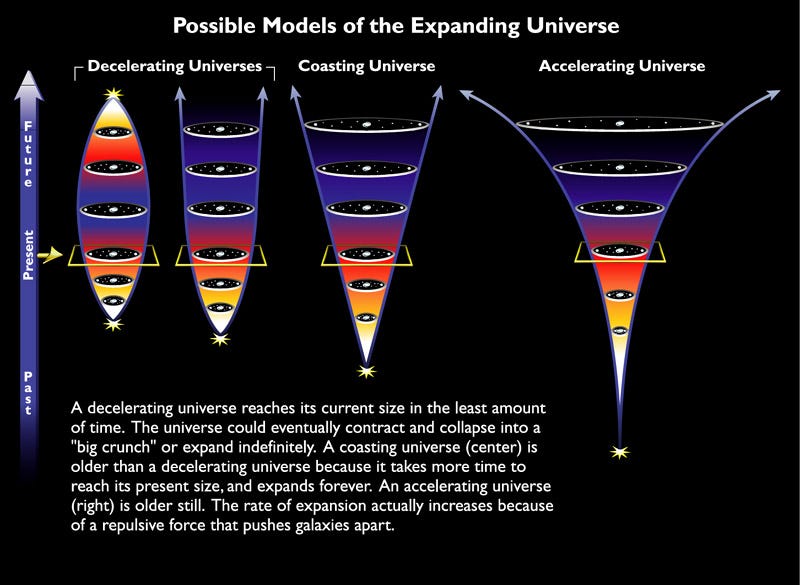
Image credit: NASA & ESA, via http://www.spacetelescope.org/images/opo9919k/.
In one sense, this is just the nature of the Universe, doing what it does by obeying the laws of physics. But in another, more thoughtful sense, this is incredibly depressing.
You see, in the three scenarios we had envisioned previously, if you left Earth in a rocket ship that could move at arbitrary speeds, you could always reach any galaxy in the observable Universe, given enough time. Sure, the more distant a galaxy was, the longer you’d have to travel to get there, but everything was reachable in principle, no matter how dim, faint or distant it was. Because gravity would decelerate the expansion rate over time, if you were dedicated enough, and traveled at a fast enough speed for a long enough time, you could inevitably run down anything in the Universe.

Image credit: Jean-Charles Cuillandre (CFHT) & Giovanni Anselmi (Coelum Astronomia), Hawaiian Starlight.
But not if our Universe is accelerating. If something is receding from us right now at more than 299,792.458 km/s — faster than light speed — and it’s accelerating too, how could anything reach it? Even a photon, moving at the speed of light, wouldn’t be able to reach such a galaxy. Instead, anything beyond that point will do something that cosmologists call red out, which means they’re sufficiently redshifted that anything we do today could never, ever reach them, and only the light they emitted in the past will ever reach us. We are already causally disconnected from them.
And one incredibly frightening thing is that any galaxy with a redshift bigger than about 1.5 (which is notthat big a number) is already gone.

NASA, ESA, H. Teplitz and M. Rafelski (IPAC/Caltech), A. Koekemoer (STScI), R. Windhorst (Arizona State University), and Z. Levay (STScI).
Consider an image like this: 10,000 of the faintest, most distant galaxies we’ve ever discovered. By measuring their redshifts, we can determine (going back to Hubble’s law) precisely how far away these galaxies are.
And as it turns out, about 40% of the galaxies in this image are already unreachable, even for a beam of light that left today. If we zoom in to this region of space and imagine what these galaxies look like as far as “depth” goes, as in the video below, we’d find that everything left in the image after about the 0:38 second mark has already redded out.
https://www.youtube.com/watch?v=wFkRCFvdtTw
And as the Universe continues on in time, more and more galaxies are redding out as the Universe continues to accelerate. With each second that goes by (on average) thousands of stars and their planetary systems cross that horizon forever, and leave our ability to reach them for all eternity. Of the hundreds of billions of galaxies (maybe even as many as a trillion) in our Universe today, only about 3% of them are still reachable. And every time a mere three years goes by, another one fades from our present reachability.

Image credit: Steve Bowers, via http://www.orionsarm.com/eg-article/48545a0f6352a.
We can always hope that some type of controlled wormhole, or spacetime-bending faster-than-light travel can save us, but there’s no evidence that such an innovation — despite our best science fiction dreams — can ever be practically realized. Until then, we’d better plan on starting our journey sooner rather than later.
Because the expansion marches on.
Readability — An Arc90 Laboratory Experiment
Follow us on Twitter »









![image-of-Armstrong-in-LM[1] image-of-Armstrong-in-LM[1]](http://lh3.googleusercontent.com/-DCIbjJ1mpBo/Va8yyRQtU1I/AAAAAAAAIkE/2MurBLbEjz0/image-of-Armstrong-in-LM%25255B1%25255D_thumb%25255B2%25255D.jpg?imgmax=800)
![image-of-a7-l_eva_diagram[1] image-of-a7-l_eva_diagram[1]](http://lh3.googleusercontent.com/-XGh3pYAcE7I/Va8y0WZykRI/AAAAAAAAIkU/XSgUn4q7bqM/image-of-a7-l_eva_diagram%25255B1%25255D_thumb%25255B1%25255D.jpg?imgmax=800)
![Image-of-AS11-40-5868[1] Image-of-AS11-40-5868[1]](http://lh3.googleusercontent.com/-rcx4OHa4R6k/Va8y2kXL9OI/AAAAAAAAIkk/KfjyexV1M6I/Image-of-AS11-40-5868%25255B1%25255D_thumb%25255B2%25255D.jpg?imgmax=800)
![image-of-a11landinggear[1] image-of-a11landinggear[1]](http://lh3.googleusercontent.com/-l-nLC5v9UIE/Va8y4BcizAI/AAAAAAAAIk0/kyj7XnBidKA/image-of-a11landinggear%25255B1%25255D_thumb%25255B2%25255D.jpg?imgmax=800)
![image-of-apollo_11_flag-raising[1] image-of-apollo_11_flag-raising[1]](http://lh3.googleusercontent.com/-AnLBL_dUXaw/Va8y6Mfv8zI/AAAAAAAAIlE/rUumEJj0E8U/image-of-apollo_11_flag-raising%25255B1%25255D_thumb%25255B2%25255D.jpg?imgmax=800)
![image-of-LM-interior[1] image-of-LM-interior[1]](http://lh3.googleusercontent.com/-hTuja9udq-k/Va8y7uwiZFI/AAAAAAAAIlU/gA6b0UqIU80/image-of-LM-interior%25255B1%25255D_thumb%25255B6%25255D.gif?imgmax=800)
![image-of-apollo11_customs_immigration_form[1] image-of-apollo11_customs_immigration_form[1]](http://lh3.googleusercontent.com/-g4hLXThou-I/Va8y90_EUUI/AAAAAAAAIlk/TCOiAAdAd2U/image-of-apollo11_customs_immigration_form%25255B1%25255D_thumb%25255B3%25255D.jpg?imgmax=800)








